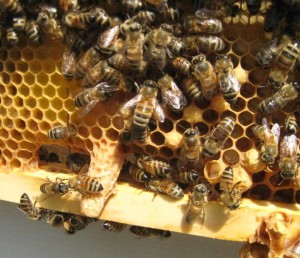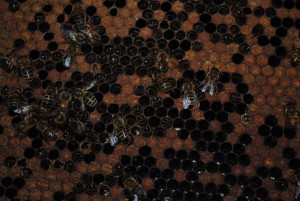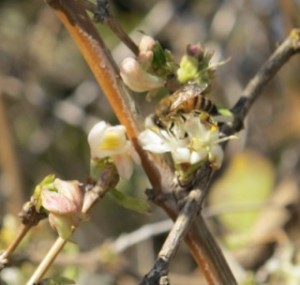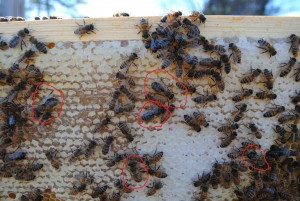New queens, Nicot mania, swarm cells and struggling hives
That pretty much sums up the last couple of days. This was my three day weekend and had long been planned as the weekend that I would be dropping queen-cells (from the queen rearing program) into various Nuc’s. Instead, I spent most of the weekend around the house (sometimes doing beekeeping chores, but mostly other stuff!), waiting for the temperatures to breach 50. Friday had some positives, Saturday had a lot of interesting events and Sunday was purely a prep day.

My first stop on Saturday was to check out a tree with bees in it. Friends had mentioned it last Fall and wanted me to ‘save’ them, so I wanted to see if they were still alive (and they were, so I hope to get that genetic pool in April – should be a quick extraction, but you know how that goes…) On a whim, I slipped by one of my nearby apiaries, remembering how they had swarmed on me last year and I still hadn’t gone into a single hive in that yard. When I arrived, it was like a melee of honey bees – there were so many coming and going from that line of hives that they were banging into my head as I made my initial, outside inspection. I tackled the most active one first (usually, I do the opposite) and immediately found 5 uncapped swarm cells on Medium frames. Checking the Deep below, I found the queen (yellow) and 8 frames of capped brood (about 75% full.) This hive was tearing it up!!
I went ahead and created two Nucs off of the hive, liberally shaking (two shakes each) bees into both Nucs (one a Medium, one a Deep). I put two (or maybe three) of the queen cells in the Medium Nuc and let the Deep Nuc raise their own. I replaced most of the frames with drawn frames, but did put some foundation in there to give them more room. I squashed the remaining cells. Note: I absolutely do not believe in this method of preventing a swarm. I honestly do not have time to check for cells every X days and I’m not sure it helps at all. My plan is to come back this weekend, after Easter Sunday, and look for more cells. If I find even one, I’ll pull several frames with the queen and let the hive go ahead and raise a new queen. I’ll use that queen as a backup queen for the Summer.
The rest of the hives in the apiary were more along the lines that I expect these days (a week to three weeks out from being big enough to spawn a Nuc). I did find one hive that could have used the old checkerboard method, but I didn’t have the equipment to do it (I will have it next weekend!)
The rest of the checks that day (there weren’t a lot, as I only had a few hours of decent weather) included one more hive that spawned a Nuc, several average hives and one hive that was well below average. The last one really surprised me a bit (I’ve become used to finding the average hive, the rare strong hive or the (fortunately) rarer dead out. I have not really found a ‘weak’ hive. This one was chock full of honey and only on 2 frames. She has a lot of brood on those two frames, but it’s the first hive that I have come across with less than 5 frames of capped brood (except the dead outs…) I’ll probably take action on this queen, but will let them roll into April before making any drastic calls.
Another bit of interest was the number of new queens that I discovered. I apparently had a lot of swarms last Fall and didn’t know it. Most were White or Blue queens, so it should be expected. I was happy to find the new ladies and mark them all (yellow).
Finally, I got the Nicot system off the ground and am hoping for a bunch of queens in a few weeks. Timing being like it is, I had to release the queen in the middle of a snow storm! The main bonus here was that I could see a ton of eggs in the system, which was a huge positive. I wasn’t sure she would get any laying done, given the events of the setup and capture. But, she did her thing! This year, I have two hives ready to take the cells, giving me the opportunity to raise over 40 queens. But, I’ll be overjoyed with just 20!



